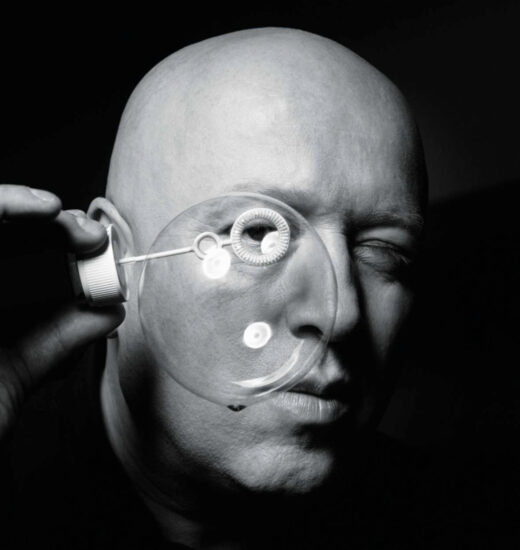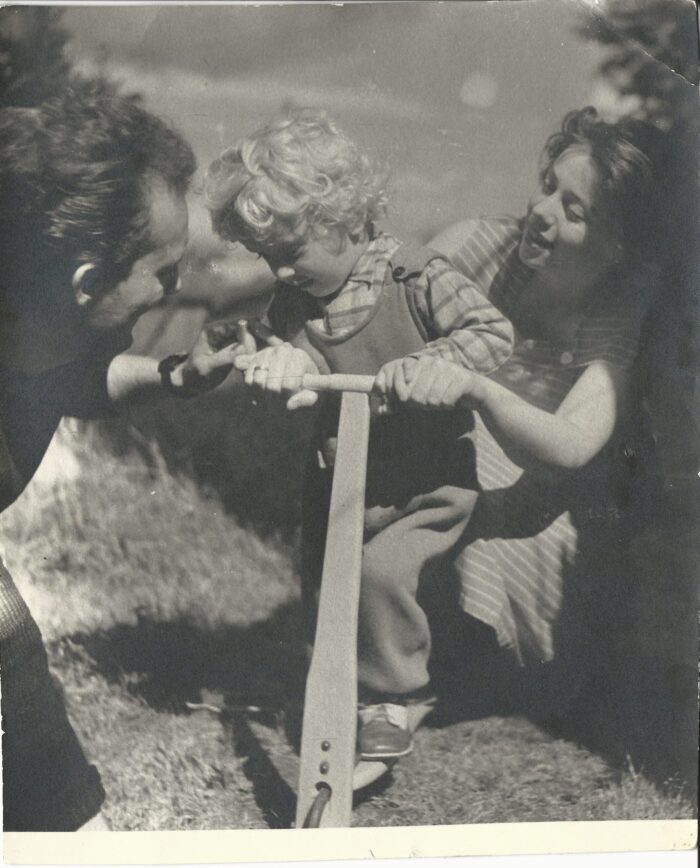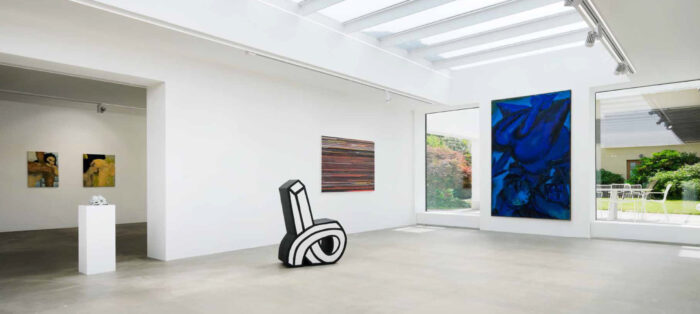born 1954 Krnov, Czech Republic.
Lives and works between Berlin, Madrid, Prague and Rio de Janerio.

Georg Dokoupil’s main subject is painting. He refuses to be subordinated to a personal style, attitude or conventional artistic approach. Instead, he operates in a free and not assignable manner right from the beginning of his career in the 1980s. The artist’s open and experimental spirit creates a wide range of visual worlds through unconventional technical inventions: he puts color on canvas with a whip or with car tires, he creates candle paintings using soot or bound oil paints into soap bubbles, only to have them burst on his canvases. The artist is fixing the ephemeral within his pictorial inventions.
Georg Dokoupil oeuvre today contains over 60 series and far more than 100 devised techniques or styles.
Biography
Jiří Dokoupil was born in Krnov, former Czechoslovakia, in 1954. After the invasion of the Soviet army in Prague in 1968, he fled with his family to Germany.
From 1976 to 1978, Dokoupil studied fine arts in Cologne, Frankfurt am Main and in New York at The Cooper Union with the conceptual artist Hans Haacke. Dokoupil was founding-member of the German artist groups Mülheimer Freiheit and Junge Wilde, which arose in the late 1970s and early 1980s. The group was associated with the legendary art dealer Paul Maenz who organized Dokoupil’s first solo exhibition in Cologne in 1982. In their shared studio in Cologne on a street named Mülheimer Freiheit, the Junge Wilde sought to explore a contemporary expression for their art by using a neo-expressive, figurative style of intensely colorful painting with traditional subjects and by overriding the intellectual, reduced formal language of Minimal and Conceptual Art. Dokoupil also taught as a guest professor at the Academy of Fine Arts of Düsseldorf from 1983 to 1984 and in Madrid during 1989.
Dokoupil developed a less wild, rather unusual working method and soon found his own radical subjective way with individual considerations. With his “book painting” shown at documenta 7 in Kassel in 1982, Dokoupil widely attracted the attention of the art world. Since then – besides the early group exhibitions with the Mülheimer Freiheit – Dokoupil’s work has been seen in numerous one-man shows in galleries, museums and at other cultural sites worldwide.

Guest teaching semesters at the following art academies:
Düsseldorf, Germany; Madrid, Spain; Amsterdam, Netherland; St. Cruz de Tenerife, Spain; Kassel, Germany; Cuenca, Spain
Selected Exhibitions:
Major solo exhibitions include Osthaus Museum Hagen (2021), Galerie Haas, Zurich, Switzerland (2020), Paul Kasmin Gallery, New York (2015); Deichtorhallen, Hamburg (2005); Palacio de Velásquez, Madrid (2000); Château de Chenonceau, France (1999); Museum Moderner Kunst Stiftung Ludwig, Wien (1997), Horsens Kunstmuseum (1991) and 1984 Museum Folkwang, Essen; Kunstmuseum Luzern, Switzerland; Groninger Museum, Groningen; Espace Lyonnais d’Art Contemporain, Lyon.
Jiří Georg Dokoupil has participated in several international exhibitions including the Venice Biennale (1987), the Jinan International Biennale in China (2022) and documenta 7 (1987). He was awarded the Lovis Corinth Prize 2012 and Karl Ernst Osthaus-Preis 2024.

Selected Public Collections:
Sammlung Pojl, Marburg Germany; Van Abbemuseum, Eindhoven, Holland; Horsens Kunstmuseum, Horsens, Denmark; Neue Galerie – Sammlung Ludwig, Aachen, Germany; Sonnabend Collection, New York, USA; Staatsgalerie, Stuttgart, Germany; Boijmans Van Beuningen, Rotterdam, The Netherlands; Kunsthaus Zürich, Switzerland; Sammlung Metzger – Museum Folkwang, Essen, Germany; Nationalgalerie, Berlin, Germany; Emanuel Hoffmann Stiftung, Basel, Switzerland; Museum Ostwall, Dortmund, Germany; Deutsche Bank, Frankfurt, Germany; National Museum of Contemporary Art, Seoul, Korea; Caixa de Pensions, Barcelona, Spain; Centre Pompidou, Paris, France; Museo Nacional Centro de Arte Reina Sofía, Madrid, Spain; Städtische Galerie Wolfsburg, Germany; CAC – Centro de Arte Contemporáneo de Malága, Malaga, Spain; CAAM – Centro Atlántico de Arte Moderno, Las Palmas de Gran Canaria, Spain; FRAC – Picardie, Amiens, France; Groninger Museum, Groningen, The Netherlands; Hamburger Bahnhof – Museum für Gegenwart, Berlin, Germany; Kunstsammlungen zu Weimar – Neues Museum, Weimar, Germany; Museum Ludwig, Köln, Germany; Städtische Galerie im Lenbachhaus, Munich, Germany; Kupferstichkabinett, Berlin, Germany; Patio Herreriano – Museo de Arte Contemporáneo Español, Valladolid, Spain; Schaulager, Münchenstein/Basel, Switzerland; Museo de Bellas Artes de Álava, Vitoria- Gasteiz, Spain; Trevi Flash Art Museum of Contemporary Art, Trevi, Italy; ZKM – Museum für Neue Kunst & Medienmuseum, Karlsruhe, Germany; Hammer Museum, Los Angeles, USA.
Selected public collections :
Van Abbemuseum, Eindhoven, Holland
Horsens Kunstmuseum, Horsens, Denmark